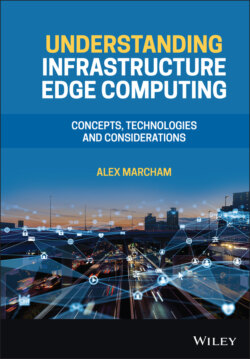Читать книгу Understanding Infrastructure Edge Computing - Alex Marcham - Страница 19
2.3.3 Device Edge
ОглавлениеThe device edge refers to the collection of devices which are located on the device side of the last mile network. Common examples of these entities include smartphones, tablets, home computers, and game consoles; it also includes autonomous vehicles, industrial robotics systems, and devices that function as smart locks, water sensors, or connected thermostats or that can provide many other internet of things (IoT) functionalities. Whether or not a device is part of the device edge is not driven by the size, cost, or computational capabilities of that device but on which side of the last mile network that it operates. This functional division clarifies the basic architecture of an edge computing system and allows several more dimensions such as ownership, device capability, or other factors to be built on top.
Figure 2.1 Infrastructure edge computing in context.
These devices may communicate directly with the infrastructure edge using the last mile network or may use an intermediary device on the device edge such as a gateway to do so. An example of each type of device is a smartphone that has an integrated Long‐Term Evolution (LTE) modem and so is able to communicate directly with the LTE last mile network itself, and a device which instead has only local range Wi‐Fi network connectivity that is used to connect to a gateway which itself has last mile network access.
In comparison to infrastructure edge computing, many devices on the device edge are powered by batteries and subject to other power constraints due to their limited size or mobile nature. It would be possible to design cooperative processing scenarios using only device edge resources in which a device can utilise compute, storage, or network resources from neighbouring devices in an ad hoc fashion; however, for the vast majority of use cases and users, these approaches have proven to be unpopular at best with users not wishing to sacrifice their own limited battery power and processing resources to participate in such a scheme at a large scale outside of outliers such as Folding@home, a distributed computing project that is focused on using a network of mains powered computers, not mobile devices. Bearing this in mind, the need for access to dense compute resources in locations as close as possible to their users is provided to users at the device edge by the infrastructure edge (see Figure 2.2).
Although this book is primarily focused on infrastructure edge computing, topics related to device edge computing will be discussed as appropriate, especially as they relate to the interaction that exists between these two key halves of the edge computing ecosystem and their interoperation.
Figure 2.2 Device edge computing in context.
